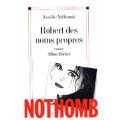Auteurs contemporains
Discours critique sur les œuvres de littérature contemporaine
Outils pour utilisateurs
Outils du site
Robert des noms propres
 Amélie Nothomb, Robert des noms propres, Paris, Albin Michel, 2002.
Amélie Nothomb, Robert des noms propres, Paris, Albin Michel, 2002.
« Le destin exceptionnel d’une petite fille prénommée Plectrude née sous les auspices les plus dramatiques et au parcours semé d’obstacles. »
Documentation critique
RICE, Alison, « “Que faire du corps ?” La maîtrise de soi dans Robert des noms propres d’Amélie Nothomb », Nouvelles études francophones, vol. 20, n° 2 (automne 2005), p. 171-183. +++ Article de revue
NODOT-KAUFMAN, Claire, « Les irrégulières. Une étude de la menstruation chez Marie Cardinal, Marie Darrieussecq, Jacqueline Harpman et Amélie Nothomb », thèse de doctorat, Department of French and Italian, University of Wisconsin-Madison, 2012, 328 p. +++ Thèse de doctorat / mémoire de maîtrise
### Résumé
« This dissertation aims to analyze the discourse on menstruation and its cultural représentation in contemporary French literature by exploring the works of four women novelists. Although almost non-existent in earlier literature, menstruation has recently become a prominent theme in French and Francophone women’s fiction. However, as reflected in the writings of Cardinal, Darrieussecq, Nothomb and Harpman, this new focus does not deviate from the traditional, patriarchal, and negatively charged représentation of menstruation. Indeed, these authors use literature to come to terms with a relationship with menstruation experienced as a burdensome process, one that is oftentimes both psychologically and physically traumatic. In each of their accounts, a diffïcult relationship with the mother is key to the trauma, which is expressed through anarchie menstrual cycles, haemorraging or amenorrhea. Because the perspective on menstruation is transmitted from mother to daughter, menstruation cornes to represent most of the issues tied to femininity and maternity.
Paradoxically, however, even as they reinforce certain clichés associated with menstruation, the four authors studied here also actively challenge restrictive and deterministic views on femininity. They emphasize that menstruation should not be construed as a defining factor in women’s identity, whether in positive or negative terms. Wary of the dangers of an essentialism that would place regular, predictable menstruation at the core of femininity, they valorize irregularity, reminding us both that only some women menstruate regularly and that regularity as a norm is debilitating. Their literary works thus contribute to the larger cultural debate now unfolding on whether menstruation is necessary or not (illustrated, for example, by recent contraceptive advances that make it possible for women to rid themselves of their menstrual cycles). Instead of defming women as cyclical, regular creatures, these authors portray irregularity as a positive value and a positive space where femininity and even gender can be renegotiated.
Table des matières de la section concernant Amélie Nothomb
IV. Amélie Nothomb : la sale viande
1. Supprimer le sang
2. Que faire des corps ? Une métaphysique des « tubes »
3. Le miroir ignoble
4. D’un spéculum à l’autre : s’échapper de la chambre cramoisie
Porte aussi sur Mercure et Hygiène de l’assassin
La version PDF de la thèse est disponible pour les membres de communautés universitaires qui ont un abonnement institutionnel auprès de UMI - Proquest###
KEMP, Anna, « The Child as Artist in Amélie Nothomb’s Robert des noms propres, French Studies: A Quarterly Review, vol. 66, n° 1 (janvier 2012), p. 54-67. +++ Article de revue
### Abstract
This article will argue that, unlike many female-authored narratives, Amélie Nothomb’s Robert des noms propres does not figure childhood as a time of freedom arising from a blissful unawareness of the body, but instead constructs childhood as an aesthetic ideal that transcends the body altogether. Far from being a space of natural liberty before the onslaught of culture, the Nothombian childhood is a disembodied space entirely colonized by the artifical and aesthetic. Indeed, the freedom of the Nothombian child is first and foremost the freedom of the artist; an artist, moreover, who produces herself as her own master-work. As such, the transition from childhood to adulthood does not so much bring an embodied self into conflict with society, as bring art into conflict with life. This article will argue that Nothomb’s staging of a clash between art and life raises questions both for critical approaches that look to women’s writing for the expression of a female self, and postmodern feminist approaches that celebrate a ‘textualization’ of this self. ###
LARKIN, Aine, « The Ballet Body Beautiful: Pleasure and Pain in Amélie Nothomb’s Robert des noms propres », dans Erika FULÖP et Adrienne ANGELO (dir.), Cherchez la femme : Women and Values in the Francophone World, Newcastle, Cambridge Scholars, 2011, p. 195-208. +++ Chapitre de collectif
McILVANNEY, Siobhán, « “Il était une fois …” : Trauma and the Fairytale in Amélie Nothomb’s Robert des noms propres », Dalhousie French Studies, n° 81 (hiver 2007), p. 19-28. +++ Article de revue
### McIlvanney, 2007, HTML ###
DAMLÉ, Amaleena, « The Becoming of Anorexia and Text in Amélie Nothomb’s Robert des noms propres and Delphine de Vigan’s Jours sans faim », dans Amaleena DAMLÉ et Gill RYE (dir.), Women’s Writing in Twenty-First-Century France: Life as Literature, Cardiff, University of Wales Press, 2013. +++ Chapitre de collectif
| Robert des noms propres (oeuvre) | |
|---|---|
| Titre | Robert des noms propres |
| Auteur | Amélie Nothomb |
| Parution | 2002 |
| Tri | Robert des noms propres |
| Afficher | oui |